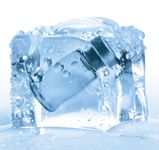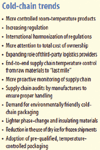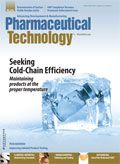Seeking Cold Chain Efficiency
Medication safety and efficacy depend on maintaining products at the proper temperature.
Pharmaceutical manufacturers devote considerable time and resources to implement effective cold-chain practices that protect products, especially sensitive biopharmaceuticals, blood products, and vaccines, from damage. Although efforts have traditionally focused on refrigerated (2–8 °C) and frozen (-20 °C) products, there is growing attention to controlled room temperature (CRT) products, which require maintenance at 15–25 °C to ensure quality and efficacy.

Maria Toutoudaki/Selahattin BAYRAM/Getty Images; Dan Ward
The emphasis on CRT shipments, expanding volumes of biologics, and rising demand from emerging markets are spurring strong growth for goods and services related to temperature-controlled logistics, particularly in Asia and the southern hemisphere. According to the 2012 Biopharma Cold Chain Sourcebook, published by Pharmaceutical Commerce, cold-chain logistics spending is forecast to grow approximately 12% from $6.5 billion in 2010 to $7.6 billion in 2013 and increase another 12.6% to reach $8.9 billion in 2016. Packaging, including instrumentation, accounts for about 37% of the dollars spent on cold-chain logistics. The focus on CRT shipments is particularly strong in Canada, Israel, Ireland, the European Union, Turkey, Saudi Arabia, and South Korea, according to Prakash Mahesh, vice-president of marketing and business development at Sonoco Protective Solutions, ThermoSafe Brands, formerly part of Tegrant.
Evolving global regulations
Regulations involving the cold chain are undergoing change. "South America, Mexico, South Africa, Saudi Arabia, and others are enforcing strict label claims," says Mahesh. In fact, he says, the European Medicines Agency (EMA) is pushing toward strict label claims and "will likely require 'proof' of protection come 2013."
With evolving regulations worldwide and dramatic growth in the number of temperature-sensitive products, it's more essential than ever to manage conditions in storage and transit. "Late-phase clinical development teams understand the need to maintain strict temperature adherence to ensure the positive outcomes in their trials as well as maintaining patient safety," says Andrew J. Mills, CEO of Americas for Intelsius, a DGP company and supplier of temperature-controlled packaging. He explains that some of the drugs coming on the market "can become toxic if frozen...or lose efficacy very quickly if warmed."
In addition, he says, "The increased FDA/EMA collaboration in overseas inspections is making the need for good cold-chain practices felt all over the globe." He explains, this regulatory attention is not only encouraging adoption of good cold-chain practices from new sectors of the marketplace, but also "bringing emerging markets up to speed with good distribution practices (GDP) compliance faster."
An e-pedigree law, scheduled to go into effect on Jan. 1, 2015 in California, is encouraging drug makers to adopt technologies that will implement traceability and cold-chain management simultaneously. A number of organizations offer resources to help companies follow GDP, including the United Kingdom's Medicines and Healthcare Products Regulatory Agency (MHRA) (1). For links to these resources, see the online version of this article at www.PharmTech.com/coldchain.
New technologies
Innovation is leading to better insulation products, the ability to maintain a specific temperature range for longer time periods, and in-transit monitoring that doesn't require the package to be opened, thereby lessening the risk of counterfeiting and diversion. Pharmaceutical packagers rely on a host of tools to maintain products at the proper temperature. Options include phase-change materials (PCMs), insulating materials, environmental data loggers, software for monitoring and tracking shipment conditions, three-dimensional modeling software to optimize package design, integration of temperature protection/monitoring by logistics providers, and temperature-controlled bulk containers to protect larger shipments.
Phase-change materials.Shippers combining vacuum-insulated panels with refrigerants based on PCMs have captured market share from traditional expanded polystyrene (EPS) and polyurethane (PUR) structures and gel packs or dry ice (2). The PCMs liquefy or solidify (freeze) at specific temperatures and recharge as ambient temperatures fluctuate. PCMs are typically preconditioned in a freezer or refrigerator before use, protect longer than gel packs, and eliminate the replenishment requirements and off-gassing hazards associated with dry ice. In addition, a single PCM unit typically replaces multiple gel packs, thereby reducing the size and weight of the transport container.
Data loggers. Data loggers are going to be more important in the future because of the trend toward greater scrutiny of the data from each shipment, says Mills of Intelsius. With data being more carefully evaluated, there will be "greater pressure on temperature-controlled packaging providers to do a better job of qualifying their solutions against multiple temperature ranges," he adds.
Data loggers record conditions the shipment experiences and can quickly indicate if a problem occurred. In some cases, units can deliver a proactive alert so that action can be taken to protect the shipment before the product becomes unusable.
Ease-of-use is maximized by features such as an onboard USB connection. "When plugged in, the logger provides PDF data files," explains Rich Ellinger, vice-president, life sciences at PakSense, the maker of a label-like data logger (BIOmed XpressPDF Temperature Monitoring Label). "No additional infrastructure is needed," says Ellinger.
Radio-frequency Identification.With wireless technology, a container does not even have to be opened to access temperature data. Keeping the shipper closed not only helps maintain the environment around the payload, but also means, "there's no need to change supply-chain practices to collect information," explains Kevin Payne, senior director of marketing at Intelleflex, a provider of radio-frequency identification (RFID) tags and related software for temperature monitoring.
Data can be read or written to a Class 3 battery-assisted passive RFID tag at distances up to 300 feet. This stronger penetration power allows readability through ice and insulation, for example (TMT-8500 temperature monitoring tag, Intelleflex). The credit-card-size tag, which measures approximately 0.25-inch thick, will gain functionality in 2013 with the addition of humidity and light-monitoring features. "Light monitoring is important because recipients can tell if the box has been opened during its travels," explains Payne.
Interest in RFID-based monitors is increasing, according to Tom Dolan, director of sales at RURO, a supplier of turnkey RFID systems. Because hundreds or even thousands of RFID tags can be scanned at the same time, the technology offers potential for high-speed automated data collection not possible with traditional barcodes. In addition, Dolan says, RFID "costs have come down, and there are more vendors in the market." Furthermore, performance improvements allow RFID tags to work reliably despite metal interference and other challenging conditions like cryo environments.
A reusable, credit-card-size tag relies on ultra-high-frequency (UHF) RFID, a five-year battery, and a tactile button to monitor temperatures from -30 to 55 °C within +/- 0.2 °C . An onboard microprocessor enables a variety of calculations, including remaining shelf life, mean kinetic temperature, and multiparameter alarms. Custom product configurations are written to each tag and easily updated in the field. Pressing the button turns the unit on, checks for compliance with preset parameters, or records the temperature at that moment. When the button is pressed, if the light-emitting diode (LED) on the tag blinks red, a temperature excursion has occurred. If the LED blinks green, programmed parameters have been met. Tags are read with a handheld or stationary reader and deliver data instantly to a CFR 21 Part 11-compliant, web-based data system. A single click identifies exceptions that may need immediate attention, and all data are archived for review and analysis. The tag, which can log thousands of time/temperature points while affixed to a package, case, or pallet, can be read and restarted at any time to record new segments, owners, or temperature parameters (UHF RFID tag and web-based monitoring system, TempTRIP).
Data access.To be actionable, temperature data must be accessible. A cloud-based data-sharing application provides access to anyone (with clearance) anywhere so timely decisions can be made about a shipment. For example, if an excursion occurs, an alert can provide instructions to move the package into the proper environment (ZEST Data Services, Intelleflex).
A provider of intelligent, reusable transport packaging relies on this data-sharing application to provide real-time alerts about potentially damaging deviations from required environmental parameters (Supply Chain Technology Solutions, Rehrig Pacific). According to Kaley Parkinson, technology sales manager at Rehrig Pacific, this high level of visibility economically addresses the industry's need for better in-transit monitoring. In fact, he predicts that future systems will integrate "with a broader range of existing systems that will streamline and simplify the transfer of information across various platforms for all...users."
Cold-chain services.Cold-chain management has become an important business for logistics providers. In fact, many airlines, parcel delivery services, and common carriers run dedicated cold-chain operations that offer high levels of environmental control and shipment visibility.
Clinical-trial specialists also are firmly focused on cold-chain services. One global supplier has expanded its cold-chain storage and distribution capacity in Pennsylvania, the UK, and Germany to maintain frozen and refrigerated products at the proper temperature (Clinical Supply Services, Catalent Pharma Solutions). "The steadily increasing number of biological products in development, particularly in prefilled syringes, is fueling the need for refrigerated storage and distribution," explains Frank Lis, vice-president and general manager of clinical supply services for Catalent Pharma Solutions.
Almac, another clinical-supplies specialist, has added refrigerated labeling facilities in the UK, thereby minimizing product exposure to temperatures outside the 2–8 °C range. The capability is mirrored at the company's US headquarters in Pennsylvania. The Northern Ireland-based firm also offers a smaller, lighter cold-chain shipper along with a temperature monitoring system (refrigerated storage/labeling areas, temperature-controlled shippers, Shipping Temperature Electronic Monitoring System, Supply Chain Management team, Almac Group). Sharon Courtney, head of distribution at Almac, reports, "In the first six months since implementation, the shippers achieved an impressive, less than 0.33% excursion rate across the board."
Bulk shipments. The need to manage shipments of larger volumes of sensitive products is encouraging development of temperature-controlled pallets, totes, and containers. Because less packaging is generally involved, shipping larger volumes can cut material and freight costs as well as the product/company's carbon footprint.
One family of bulk containers maintains entire pallet loads at refrigerated or controlled room temperatures for up to 120 hours. Easily assembled with lightweight insulated panels, the units hold half- or full-pallet loads (including the pallet) and can be single use or reusable. In-house testing confirms that each container performs to shipper or third-party specifications and is delivered with full documentation (Repak line of pallet shippers, Cryopak, division of TCP Reliable).
PUR-insulated pallet shippers with self-supporting panels require no more than 15 minutes for assembly. Patented components provide structural stability and air flow for top and bottom refrigerants. The design is "a first in the industry," says Vicki Arthur, vice-president of Sonoco's Protective Packaging Division, and "can use the same configuration for all seasons" (ThermoSafe SPS Series Pallet Shippers, ThermoSafe Brands, a unit of Sonoco).
AbbVie, the newly spun-off biopharmaceutical operations of Abbott, has adopted Sonoco's ThermoSafe PUR-insulated pallet shippers for 2–8 °C shipments from its home base in Chicago to Latin America. Two types of PCM serve as the refrigerant. The PUR/PCM system replaces a PUR/water system, which is itself a replacement for an EPS/water configuration. Requirements included maintaining 2–8 °C for 96 hours in summer and winter conditions encountered in the company's preferred transport/distribution model. The shippers also needed to be able to maintain 2–8 °C if refrigerated anytime before 96 hours. Tests showed that the system, with small variations in the arrangement of the PCM units, maintains the payload at the proper temperature for 120 or more hours regardless of the season or size of the shipper (e.g., pallet, half-pallet, parcel). Because the PCM weighs less than the water refrigerants used previously, it increases the system's weight-to-payload-efficiency and payload-to-box ratios. The PUR/PCM system also simplifies pack-out, accommodates transport delays, and reduces total cost of ownership. "The shipping system works as well and in many cases better than active shipping systems," reported Arminda Montero, then Abbott's (now AbbVie's) global distribution quality assurance program manager during a presentation in September 2012 at IQPC's Cold Chain & Temperature Management Global Forum in Chicago (3). In fact, the PUR/PCM configuration performed so well on the Chicago/Latin America route that it is now used for all of the company's international shipments.
Cardinal Health has adopted temperature-controlled totes for its 2–8 °C products. Available in two sizes, the totes feature an insulating liner and lid of EPS and replace gel packs with two types of pillow-like PCM panels. The orange PCM panels are preconditioned to refrigerator temperatures (to protect from freezing conditions) while the green PCM panels start out frozen (to protect from heat). The orange panels absorb the energy from the green panels (as well as external winter temperatures) and begin to solidify (freeze) at approximately 4 °C, protecting the product from experiencing temperatures below the labeled range. As the temperature inside the tote changes, the physical state of panels shift between solid and liquid to maintain the shipment at 2–8 °C. Product is bagged to protect it from condensation or a leak of PCM. The nontoxic PCM is derived from renewable resources and considered a bio-preferred product by the US Department of Agriculture (4).
Going forward
Eventually, temperature-controlled shipping standards will be harmonized internationally. Near term, scrutiny will increase on every point in the supply chain, including mail order pharmacies. In fact, Ellinger of PakSense predicts, "more tracking of products throughout the entire cold-chain continuum—including the 'last mile.'" Bill Hingle, director of marketing at Cryopak, a division of TCP Reliable, agrees, noting that the many variables involved with protecting product to the point of use make the last mile the weakest link in the cold chain.
Hingle also forecasts a shift from looking at packaging costs alone to considering all expenses related to maintaining products at the proper temperature during storage and transport. This change in financial tactics will coincide with a move away from more generic temperature-controlled packaging options to "truly qualified and validated solutions," says Mills of Intelsius.

Cold-chain trends
The stronger emphasis on the big picture will prompt more partnerships among carriers, pharmaceutical manufacturers and distributors, and logistics providers to proactively monitor the cold chain. As a result, we'll see greater use of smart containers that can compensate for unexpected events like summer-time temperatures in February in New York City or a diverted flight that translates into eight extra hours on the tarmac in extreme heat or cold. "You don't want to lose high-value product or product that's in short supply or critically needed," concludes Payne of Intelleflex.
References
1. MHRA, "Good Distribution Practice," www.mhra.gov.uk/Howweregulate/Medicines/Inspectionandstandards/GoodDistributionPractice, accessed Jan. 2, 2013.
2. H. Forcinio, Pharm. Tech. 36 (9) 34-36 (2012).
3. A. Montero, P. Mahesh, and K. Maltas, "Case Study: Designing 2–8 °C Shippers for International Shipments from US to Latin America," presentation at IQPC's Cold Chain & Temperature Management Global Forum (Chicago, IL, 2012).
4. Cardinal Health, "Cold Chain–Refrigerated Tote Qualification," www.cardinalhealth.com, accessed Jan. 2, 2013.
Cold-chain management resources
Cold Chain IQ, a sub-group of Pharma IQ, http://www.linkedin.com
Cool Chain Association, http://www.coolchain.org
European Union, “Guidelines on Good Distribution Practice of Medicinal Products for Human Use (94/C 63/03),” http://ec.europa.eu/health/files/eudralex/vol-4/gdpguidelines1.pdf
Health Canada, “Guidelines for Temperature Control of Drug Products during Storage and Transportation (GUI-0069),” http://www.hc-sc.gc.ca/dhp-mps/compli-conform/gmp-bpf/docs/gui-0069-eng.php
International Air Transport Association, “Air Transport Logistics for Time and Temperature Sensitive Healthcare Products, Chapter 17” in Perishable Cargo Regulations, http://www.iata.org/publications/Pages/perishable-cargo.aspx
ISPE, “Good Practice Guide: Cold Chain Management,” http://www.ISPE.org/Publications
Medicines and Healthcare Products Regulatory Agency, “Good Distribution Practice: Guidance and Legislation,” http://www.mhra.gov.uk/Howweregulate/Medicines/Inspectionandstandards/GoodDistributionPractice/Guidanceandlegislation/index.htm#9
Pharmaceutical Cold Chain Interest Group, http://www.pda.org
Temperature Assurance Group, http://www.linkedin.com
USP General Chapter 659, “Packaging and Storage Requirements,” (will be official in USP 37-NF 32 in May 2014), http://www.usp.org
USP General Chapter 1079, “Good Storage and Shipping Practices” (2012), http://www.usp.org
USP General Chapter 1083, “Good Distribution Practices – Supply Chain Integrity,” (being reworked based on comments received from the Pharmacopeial Forum proposal and a public workshop in May 2012), http://www.usp.org
USP General Chapter 1118, “Monitoring Devices-Time, Temperature, and Humidity” (2013), http://www.usp.org
World Health Organization, “Guidelines on the International Packaging and Shipping of Vaccines,” http://www.who.int/vaccines-documents/DoxGen/H5-CC.htm

Pharmaceutical Tariffs Are Imminent: How Industry is Bracing for Impact
April 16th 2025On April 14, 2025, the Trump Administration launched a national security-driven investigation into pharmaceuticals, a move that will likely result in tariffs being placed on pharmaceutical drugs, ingredients, and other components that are imported from outside of the United States.
Drug Solutions Podcast: A Closer Look at mRNA in Oncology and Vaccines
April 30th 2024In this episode fo the Drug Solutions Podcast, etherna’s vice-president of Technology and Innovation, Stefaan De Koker, discusses the merits and challenges of using mRNA as the foundation for therapeutics in oncology as well as for vaccines.